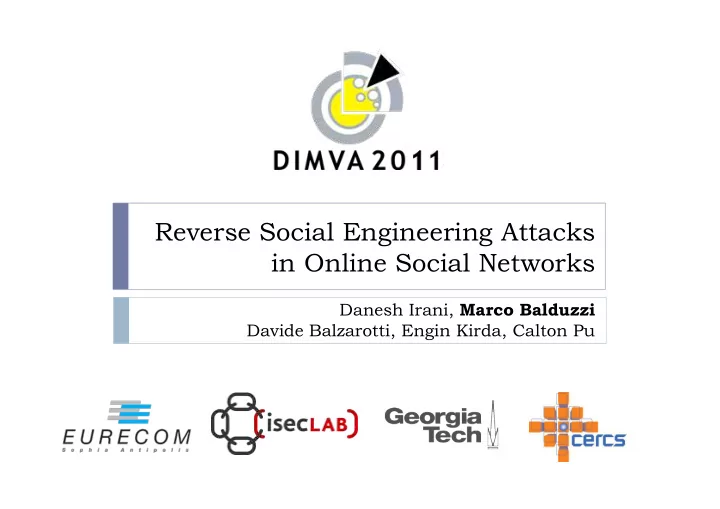

Reverse Social Engineering Attacks in Online Social Networks Danesh Irani, Marco Balduzzi Davide Balzarotti, Engin Kirda, Calton Pu
Motivations Social Networks have experienced a huge surge in popularity Facebook has more than 500 Million users: http://www.facebook.com/press/info.php?statistics The amount of personal information they store requires appropriate security precautions People are not aware of all the possible way in which these info can be abused A simple problem can result in serious consequences for thousands of Social Networks users 2 July 7-8th, 2011 Amsterdam, The Netherlands
Social Engineering Social engineering is the art of manipulating people into performing actions or divulging confidential information, rather than by breaking in or using technical cracking techniques 3 July 7-8th, 2011 Amsterdam, The Netherlands
Reverse Social Engineering Attacks in Social Networks Classic Social Engineering: The attacker contacts his victim RSE: The attacker… 1. feeds his victim with a pretext (baiting) 2. waits for victim to make the initial approach Victim less suspicious as she makes the initial contact Bypasses current behavioral and filter-based detection Potential to reach millions of users on social networks 4 July 7-8th, 2011 Amsterdam, The Netherlands
Facebook Initial Experiment Last year (RAID 2010): “Abusing Social Networks for Automated User Profiling” 5 July 7-8th, 2011 Amsterdam, The Netherlands
Facebook Initial Experiment The account used in that research received a large number of friend requests Hit the limit : 25,000 6 July 7-8th, 2011 Amsterdam, The Netherlands
Facebook Initial Experiment Results 7 July 7-8th, 2011 Amsterdam, The Netherlands
Facebook Initial Experiment Results About 500,000 email queried 3.3% friend connect rate in 3 months Cascading effect based on reputation 0.37% average friend connect rate per month 8 July 7-8th, 2011 Amsterdam, The Netherlands
3 Types of Real-World RSE Attacks Recommendation-Based Mediated attack where Recommendation System performs baiting 9 July 7-8th, 2011 Amsterdam, The Netherlands
3 Types of Real-World RSE Attacks Demographic-Based – Mediated Visitor Tracking-Based – Direct 10 July 7-8th, 2011 Amsterdam, The Netherlands
Experiment RSE attack on Facebook, Badoo and Friendster Determine characteristics which make profiles effective 11 July 7-8th, 2011 Amsterdam, The Netherlands
Ethical and Legal Considerations We consulted with the legal department of our institution (comparable to the Institute Review Board (IRB) in the US) and our handling and privacy precautions were deemed appropriate and consistent with the European legal position. When the data was analyzed, identifiers (e.g., names) were anonymized, and only aggregate analysis of the collected data was performed. 12 July 7-8th, 2011 Amsterdam, The Netherlands
Recommendation Based (Facebook) 50,000 profiles queried per attack profile Profiles 2 and 3 (girls) most successful Profile 5 least effective 94% of messages sent after friend requests Most common 3-grams: “suggested you as” or “suggest I add” The baiting works 13 July 7-8th, 2011 Amsterdam, The Netherlands
Recommendation Based (Facebook) Majority of victims attracted: Single Young users who expressed interest in “Women” Profile 1 received a large number of requests from users expressing interest in “Men” Profile 5 attracted largest number of requests from older users 14 July 7-8th, 2011 Amsterdam, The Netherlands
Demographic Based (Badoo) Created the fake profiles and occasionally updated to remain in search Profile 5 was removed Profiles 2 and 3 most successful again Profile 5 not using actual photo was disabled 50% of visitors messaged Profile 2 and 3 (44% avg.) Most common 3-grams: “how are you”, “get to know”, and “would you like” Face-to-face relation 15 July 7-8th, 2011 Amsterdam, The Netherlands
Demographic Based (Badoo) Most users who expressed interest were “Single”. Attracted users interested in their gender and approximate age group. Profile 1 received large interest from younger profiles. Profile 4 from older profiles. 16 July 7-8th, 2011 Amsterdam, The Netherlands
Visitor Based (Friendster) 42,000 users visited per attack profile Number of users visited attack profiles back, consistent with Facebook 0.25% to 1.2% per month Number of following friend requests or mess- ages low in comparison Demographics similar to Facebook 17 July 7-8th, 2011 Amsterdam, The Netherlands
Lessons Learned Pretexting – critical for RSE attacks Excuse needed to “break the ice” Recommendation systems (e.g. Facebook) provide strongest pretext The Visitor Based attack was not effective (e.g. Friendster) Profile effectiveness Attractive female profiles are highly successful Can be tuned to demographics of target victim(s) (e.g. Badoo) 18 July 7-8th, 2011 Amsterdam, The Netherlands
Countermeasures Perform recommendations based on very strong links Ensure at least a few friends in common (or within n-degrees of separation) Adapt behavioural techniques to RSE techniques Check accounts only performing a single action Ensure bi-directional activity (i.e. profile also searches and adds users) CAPTCHAs for incoming friend requests 19 July 7-8th, 2011 Amsterdam, The Netherlands
Questions 20 July 7-8th, 2011 Amsterdam, The Netherlands
Recommend
More recommend